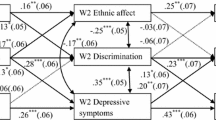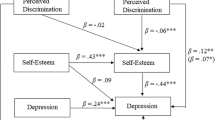Abstract
This study focused on the perceptions of discrimination for Chinese American adolescents: how perceptions changed over time, how generational status and acculturation were related to these changes, and whether earlier discrimination experiences were related to subsequent depressive symptomatology. The sample included 309 Chinese American adolescents who participated in a 2 year, three-wave longitudinal study. Findings suggest that perceptions of discrimination became more acute over time for the majority of Chinese American adolescents in our study, that greater initial levels of perceptions of discrimination predicted a slower orientation to U.S. culture, that discrimination was not related to orientation to Chinese culture, and that an increase in perceptions of discrimination was associated with an increase in depressive symptoms. Greater orientation to Chinese culture was also related to fewer depressive symptoms. The findings are discussed in light of the unique cultural context of the study.



Similar content being viewed by others
References
Alvarez, A., Juang, L., & Liang, C. (2006). Asian Americans and racism: When bad things happen to “model minorities”. Cultural diversity and ethnic minority psychology, 2(3), 477–492. doi:10.1037/1099-9809.12.3.477.
Berry, J. W. (2003). Conceptual approaches to acculturation. In K. Chun, P. Balls-Organista, & G. Martin (Eds.), Acculturation: Advances in theory, measurement, and applied research (pp. 17–37). Washington: American Psychological Association Press.
Berry, J. W., & Kim, U. (1988). Acculturation and mental health. In P. R. Dasen, J. W. Berry, & N. Sartorius (Eds.), Health and cross-cultural psychology: Towards application (pp. 207–236). Newbury Park, CA: Sage.
Berry, J. W., Kim, U., Minde, T., & Mok, D. (1987). Comparative studies of acculturative stress. The International Migration Review, 1(3), 491–511. doi:10.2307/2546607.
Berry, J. W., Phinney, J. S., Sam, D., & Vedder, P. (2006). Immigrant youth in cultural transition: Acculturation, identity and adaptation across national contexts. Mahwah, NJ: Lawrence Erlbaum.
Brown, J. S., Meadows, S. O., & Elder, G. H. (2007). Race-ethnic inequality and psychological distress: Depressive symptoms from adolescence to young adulthood. Developmental Psychology, 43(6), 1295–1311. doi:10.1037/0012-1649.43.6.1295.
Castro, J. R., & Rice, K. G. (2003). Perfectionism and ethnicity: Implications for depressive symptoms and self-reported academic achievement. Cultural diversity and ethnic minority psychology, 9(1), 64–78. doi:10.1037/1099-9809.9.1.64.
Curran, P. J., & Bollen, K. A. (2001). The best of both worlds: Combining autoregressive and latent curve models. In L. Collins & A. Sayer (Eds.), New methods for the analysis of change (pp. 107–135). Washington, DC: American Psychological Association.
Duncan, T. E., Duncan, S. S., & Strycker, L. A. (2006). An introduction to latent variable growth curve modeling: Concepts, issues, and applications. Mahwah, NJ: Lawrence Erlbaum.
Fisher, C. B., Wallace, S. A., & Fenton, R. E. (2000). Discrimination distress during adolescence. Journal of Youth and Adolescence, 29, 679–695. doi:10.1023/A:1026455906512.
Fuligni, A. (2001). A comparative longitudinal approach to acculturation among children from immigrant families. Harvard Educational Review, 71(3), 566–578.
Garcia Coll, C., Crnic, K., Lamberty, G., Wasik, B. H., Jenkins, R., Garcia, H. V., et al. (1996). An integrative model for the study of developmental competencies in minority children. Child Development, 67, 1891–1914. doi:10.2307/1131600.
Garnefski, N., Legerstee, J., Kraaij, V., van de Kommer, T., & Teerds, J. (2002). Cognitive coping strategies and symptoms of depression and anxiety: A comparison between adolescents and adults. Journal of Adolescence, 5(6), 603–611. doi:10.1006/jado.2002.0507.
Garrod, A., & Kilkenny, R. (2007). Balancing two worlds: Asian American college students tell their life stories. Ithaca, NY: Cornell University Press.
Gee, G. C., Spencer, M. S., Chen, J., & Takeuchi, D. (2007). A nationwide study of discrimination and chronic health conditions among Asian Americans. American Journal of Public Health, 7(7), 1275–1282. doi:10.2105/AJPH.2006.091827.
Gil, A., & Vega, W. (1996). Two different worlds: Acculturation stress and adaptation among Cuban and Nicaraguan families. Journal of Social and Personal Relationships, 3(3), 435–456. doi:10.1177/0265407596133008.
Goto, S., Gee, G., & Takeuchi, D. (2002). Strangers still? The experience of discrimination among Chinese Americans. Journal of Community Psychology, 30(2), 211–224. doi:10.1002/jcop.9998.
Graves, T. (1967). Psychological acculturation in a tri-ethnic community. South-Western Journal of Anthropology, 23, 337–350.
Greenberger, E., & Chen, C. (1996). Perceived family relationships and depressed mood in early and late adolescence: A comparison of European and Asian Americans. Developmental Psychology, 32(4), 707–716. doi:10.1037/0012-1649.32.4.707.
Greene, M. L., Way, N., & Pahl, K. (2006). Trajectories of perceived adult and peer discrimination among Black, Latino, and Asian American adolescents: Patterns and psychological correlates. Developmental Psychology, 42(2), 218–238. doi:10.1037/0012-1649.42.2.218.
Inhelder, B., & Piaget, J. (1958). The growth of logical thinking from childhood to adolescence. New York: Basic Books.
Keating, D. P. (2004). Cognitive and brain development. In R. Lerner & L. Steinberg (Eds.), Handbook of adolescent psychology (2nd ed., pp. 45–84). Hoboken, NJ: John Wiley & Sons Inc.
Kim, S. Y., Gonzales, N. A., Stroh, K., & Wang, J. J. L. (2006). Parent-child cultural marginalization and depressive symptoms in Asian American family members. Journal of Community Psychology, 34(2), 167–182. doi:10.1002/jcop.20089.
Lee, R. (2003). Do ethnic identity and other-group orientation protect against discrimination for Asian Americans? Journal of Counseling Psychology, 50(2), 133–141.
Lee, R. (2005). Resilience against discrimination: Ethnic identity and other group orientation as protective factors for Korean Americans. Journal of Counseling Psychology, 52(1), 36–44.
Liang, C. T. H., Li, L. C., & Kim, B. K. S. (2004). The Asian American racism-related stress inventory: Development, factor analysis, reliability, and validity. Journal of Counseling Psychology, 51, 103–114. doi:10.1037/0022-0167.51.1.103.
Muthén, L. K., & Muthén, B. (2001). Mplus user’s guide. Los Angeles, CA: Muthén & Muthén.
Nguyen, H. H. (2004, July). Discrimination, acculturation, and adjustment. Paper presented at the annual meeting of the American Psychological Association, Honolulu, HI.
Nguyen, H. H., Messé, L. A., & Stollak, G. E. (1999). Toward a more complex understanding of acculturation and adjustment. Journal of Cross-Cultural Psychology, 30(1), 5–31. doi:10.1177/0022022199030001001.
Noh, S., & Kasper, V. (2003). Perceived discrimination and depression: Moderating effects of coping, acculturation, and ethnic support. American Journal of Public Health, 93, 232–238. doi:10.2105/AJPH.93.2.232.
Phinney, J. S. (2003). Ethnic identity and acculturation. In K. M. Chun, P. B. Organista, & G. Marin (Eds.), Acculturation: Advances in theory, measurement, and applied research (pp. 63–81). Washington, DC: American Psychological Association.
Phinney, J. S., Berry, J. W., Vedder, P., & Liebkind, K. (2006). The acculturation experience: Attitudes, identities, and behaviors of immigrant youth. In J. W. Berry, J. S. Phinney, D. Sam, & D. P. Vedder (Eds.), Immigrant youth in cultural transition: Acculturation, identity and adaptation across national contexts (pp. 71–116). Mahwah, NJ: Lawrence Erlbaum.
Phinney, J. S., & Chavira, V. (1995). Parental ethnic socialization and adolescent coping with problems related to ethnicity. Journal of Research on Adolescence, 5, 31–53. doi:10.1207/s15327795jra0501_2.
Phinney, J. S., & Devich-Navarro, M. (1997). Variations in bicultural identification among African American and Mexican American adolescents. Journal of Research on Adolescence, 7(1), 3–32. doi:10.1207/s15327795jra0701_2.
Portes, A., & Rumbaut, R. G. (1996). Immigrant America: A portrait (2nd ed.). Berkeley, CA: University of California Press.
Portes, A., & Rumbaut, R. G. (2001). Legacies: The story of the second generation. Berkeley, CA: University of California Press.
Radloff, L. S. (1977). The CES-D scale: A self-report depression scale for research in the general population. Applied Psychological Measurement, 1, 385–401. doi:10.1177/014662167700100306.
Romero, A. J., Carvajal, S. C., Volle, F., & Orduña, M. (2007). Adolescent bicultural stress and its impact on mental well-being among Latinos, Asian Americans, and European Americans. Journal of Community Psychology, 35(4), 519–534. doi:10.1002/jcop.20162.
Rosenbloom, S. R., & Way, N. (2004). Experiences of discrimination among African American, Asian American, and Latino adolescents in an urban high school. Youth and Society, 35, 420–451. doi:10.1177/0044118X03261479.
Takaki, R. (1998). A history of Asian Americans: Strangers from a different shore. Little, Brown: New York.
U.S.Bureau of the Census. (2003a). Current population reports: School enrollment–social and economic characteristics of students (pp. P20–P554). Washington, DC: Author.
U.S.Bureau of the Census. (2003b). American community survey: Data profiles: San Francisco. Washington, DC: Author.
U.S.Bureau of the Census. (2007). Annual population estimates. Washington, DC: Author.
U.S.Bureau of the Census. (2008). Facts for features: Asian American heritage month, may 2008. Washington, DC: Author.
Verkuyten, M., & Thijs, J. (2006). Ethnic discrimination and global self-worth in early adolescents: The mediating role of ethnic self-esteem. International Journal of Behavioral Development, 30(2), 107–116. doi:10.1177/0165025406063573.
Wong, B. (1998). Ethnicity and entrepreneurship: The new Chinese immigrants in the San Francisco bay area. Boston: Allyn & Bacon.
Wong, C. A., Eccles, J. S., & Sameroff, A. (2003). The influence of ethnic discrimination and ethnic identification on African American adolescents’ school and socioemotional adjustment. Journal of Personality, 71, 1197–1232. doi:10.1111/1467-6494.7106012.
Ying, Y. W. (1988). Depressive symptomatology among Chinese-Americans as measured by the CES-D. Journal of Clinical Psychology, 44(5), 739–746. doi:10.1002/1097-4679(198809)44:5<739::AID-JCLP2270440512>3.0.CO;2-0.
Ying, Y. W. (1996). Satisfaction of Chinese Americans: An empirical examination. Journal of Community Psychology, 24(1), 3–16. doi:10.1002/(SICI)1520-6629(199601)24:1<3::AID-JCOP1>3.0.CO;2-1.
Ying, Y. W., Lee, P., & Tsai, J. (2000). Cultural orientation and racial discrimination: Predictors of coherence in Chinese American young adults. Journal of Community Psychology, 28(4), 427–442. doi:10.1002/1520-6629(200007)28:4<427::AID-JCOP5>3.0.CO;2-F.
Yip, T., Gee, G. C., & Takeuchi, D. T. (2008). Racial discrimination and psychological distress: The impact of ethnic identity and age among immigrant and United States-born Asian adults. Developmental Psychology, 44(3), 787–800. doi:10.1037/0012-1649.44.3.787.
Zhou, M., & Bankston, C. (1998). Growing up American: How Vietnamese children adapt to life in the United States. New York: Russell Sage Foundation.
Acknowledgment
This research was supported by Grant MH61573 from the National Institute of Health. We are grateful to the adolescents and parents who participated in the study.
Author information
Authors and Affiliations
Corresponding author
Rights and permissions
About this article
Cite this article
Juang, L.P., Cookston, J.T. Acculturation, Discrimination, and Depressive Symptoms among Chinese American Adolescents: A Longitudinal Study. J Primary Prevent 30, 475–496 (2009). https://doi.org/10.1007/s10935-009-0177-9
Received:
Accepted:
Published:
Issue Date:
DOI: https://doi.org/10.1007/s10935-009-0177-9




